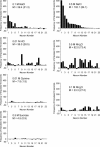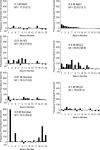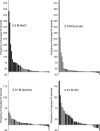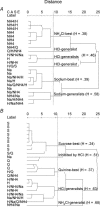In vivo recordings from rat geniculate ganglia: taste response properties of individual greater superficial petrosal and chorda tympani neurones
- PMID: 15746166
- PMCID: PMC1464453
- DOI: 10.1113/jphysiol.2005.083741
In vivo recordings from rat geniculate ganglia: taste response properties of individual greater superficial petrosal and chorda tympani neurones
Abstract
Coding of gustatory information is complex and unique among sensory systems; information is received by multiple receptor populations located throughout the oral cavity and carried to a single central relay by four separate nerves. The geniculate ganglion is the location of the somata of two of these nerves, the greater superficial petrosal (GSP) and the chorda tympani (CT). The GSP innervates taste buds on the palate and the CT innervates taste buds on the anterior tongue. To obtain requisite taste response profiles of GSP neurones, we recorded neurophysiological responses to taste stimuli of individual geniculate ganglion neurones in vivo in the rat and compared them to those from the CT. GSP neurones had a distinct pattern of responding compared to CT neurones. For example, a small subset of GSP neurones had high response frequencies to sucrose stimulation, whereas no CT neurones had high response frequencies to sucrose. In contrast, NaCl elicited high response frequencies in a small subset of CT neurones and elicited moderate response frequencies in a relatively large proportion of GSP neurones. The robust whole-nerve response to sucrose in the GSP may be attributable to relatively few, narrowly tuned neurones, whereas the response to NaCl in the GSP may relate to proportionately more, widely tuned neurones. These results demonstrate the diversity in the initial stages of sensory coding for two separate gustatory nerves involved in the ingestion or rejection of taste solutions, and may have implications for central coding of gustatory quality and concentration as well as coding of information used in controlling energy, fluid and electrolyte homeostasis.
Figures








Similar articles
-
Gustatory responsiveness of fibers in the hamster glossopharyngeal nerve.J Neurophysiol. 1988 Aug;60(2):478-98. doi: 10.1152/jn.1988.60.2.478. J Neurophysiol. 1988. PMID: 3171639
-
Taste-responsive neurons of the glossopharyngeal nerve of the rat.J Neurophysiol. 1991 Jun;65(6):1452-63. doi: 10.1152/jn.1991.65.6.1452. J Neurophysiol. 1991. PMID: 1875254
-
Different characteristics of gustatory responses between the greater superficial petrosal and chorda tympani nerves in the rat.Chem Senses. 1997 Apr;22(2):133-40. doi: 10.1093/chemse/22.2.133. Chem Senses. 1997. PMID: 9146903
-
[Progress in the effects of injury and regeneration of gustatory nerves on the taste functions in animals].Sheng Li Xue Bao. 2014 Oct 25;66(5):519-27. Sheng Li Xue Bao. 2014. PMID: 25331997 Review. Chinese.
-
Responses to umami substances in taste bud cells innervated by the chorda tympani and glossopharyngeal nerves.J Nutr. 2000 Apr;130(4S Suppl):950S-3S. doi: 10.1093/jn/130.4.950S. J Nutr. 2000. PMID: 10736359 Review.
Cited by
-
Oral thermosensing by murine trigeminal neurons: modulation by capsaicin, menthol and mustard oil.J Physiol. 2019 Apr;597(7):2045-2061. doi: 10.1113/JP277385. Epub 2019 Feb 10. J Physiol. 2019. PMID: 30656684 Free PMC article.
-
Regional specialization of the tongue revealed by gustatory ganglion imaging.iScience. 2022 Dec 1;25(12):105700. doi: 10.1016/j.isci.2022.105700. eCollection 2022 Dec 22. iScience. 2022. PMID: 36582484 Free PMC article.
-
Characteristics of calcium currents in rat geniculate ganglion neurons.J Neurophysiol. 2011 Jan;105(1):224-34. doi: 10.1152/jn.00636.2010. Epub 2010 Nov 10. J Neurophysiol. 2011. PMID: 21068265 Free PMC article.
-
Variable Branching Characteristics of Peripheral Taste Neurons Indicates Differential Convergence.J Neurosci. 2021 Jun 2;41(22):4850-4866. doi: 10.1523/JNEUROSCI.1935-20.2021. Epub 2021 Apr 19. J Neurosci. 2021. PMID: 33875572 Free PMC article.
-
Taste buds: cells, signals and synapses.Nat Rev Neurosci. 2017 Aug;18(8):485-497. doi: 10.1038/nrn.2017.68. Epub 2017 Jun 29. Nat Rev Neurosci. 2017. PMID: 28655883 Free PMC article. Review.
References
-
- Beidler LM. Properties of chemoreceptors of tongue of rat. J Neurophysiol. 1953;16:595–607. - PubMed
-
- Boudreau JC, Hoang NK, Oravec J, Do LT. Rat neurophysiological taste responses to salt solutions. Chem Senses. 1983;8:131–150.
-
- Bradley RM. Sensory receptors of the larynx. Am J Med. 2000;108:47S–50S. - PubMed
Publication types
MeSH terms
Grants and funding
LinkOut - more resources
Full Text Sources

